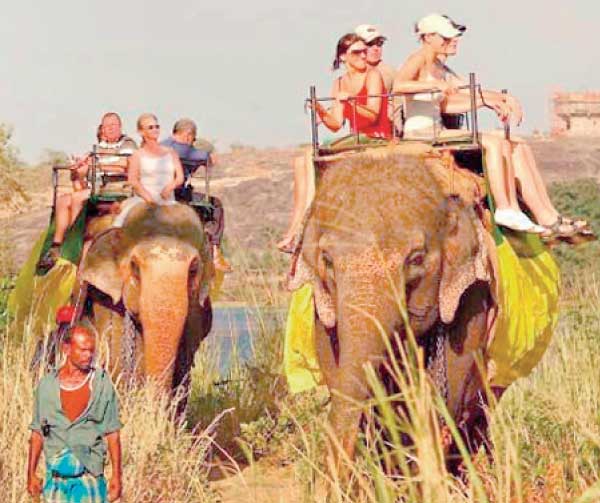09 Feb 2016 - {{hitsCtrl.values.hits}}


In Sri Lankan tourism, riding an elephant has become one of the key attractions.
Due to this we find many elephants in the country being victims of cruelty and inhumane treatment in the name of tourism. While there are set guidelines on the treatment of elephants, they are visibly not followed, and the laws on cruelty to animals in Sri Lanka dating back to 1907 fail to address this issue in an effective manner. This in turn highlights the need for effective laws to address issues on cruelty to animals, and to speed up the passing of the Animal Welfare Bill in Sri Lanka.
Elephant rides and animal suffering
As fun it might seem for some tourists to ride elephants, the elephants have to undergo great suffering even before a man decides to get on his back for the man’s amusement. Elephants that are used for elephant rides are fitted with a crude metal cage that resembles a bed frame which could weigh more than 50 kgs. And in order to keep the structure securely fitted, the cage is fitted using ropes tightly tied around the elephants spine.
Deepani Jayantha, Veterinarian, Country Coordinator of Elemotion Foundation and a member of Animal Welfare Coalition commented on the crude nature in which these frames are fitted, and the pain and suffering that the elephants endure due to these practices.
“Elephants used for these rides for tourism purposes in Habarana and Sigiriya are fitted with a metal cage that resembles a bed frame that could weigh up to and over 50 kgs. The elephant dorsum is not anatomically designed to hold such structures or to carry heavy loads. This could damage the elephant’s dorsum and the pelvic area.”
She also explained that the continuous friction could cause wounds and that tension exerted by the ropes and straps on their chest can cause pressure on internal organs.
“Long term use of cages have reportedly resulted in chronic wounds (pressure wounds), abscesses and joint pain. And the whole process itself is a chronic stress for the animal,” she added.
It is not only the cage that the elephants suffer, but also the long working hours. According to Deepani, the elephants provide rides from 0700-1100hrs and 1500-1800hrs, which could be further prolonged depending on the day’s weather and the circumstances.
Controlling elephants
Another instance when cruelty is suffered by these animals is caused when the elephants are controlled for the purpose of providing rides. Given that captive elephants need controlling, with their wild traits not been made docile, the owners tend to create obedience through submission to fear. Commanding, whacking and jabbing with the ankus or elephant goad are traditional restraining methods. Spiked chains, hobbles and shackles are also reported to be used for purposes for controlling them as well.
“In extreme cases elephants are hit on their head, where sensitivity is higher, which could cause injury to the eye. There was an incident where an elephant in Habarana was found with spiked chain shackles, cut and jab wounds and burns on its lips. These are situations we should put an end to,” added Deepani.
Guidelines and Animal Welfare Laws
The Sri Lanka Tourism Development Authority has introduced a set of guidelines for managing riding elephants. The guidelines provides that five freedoms must be enjoyed by elephants in captivity which include being free from malnutrition, terminal physical discomfort, injury and disease, fear and stress and to express normal patterns and behaviour.
The guidelines also include the need for light structures with a mattress to be used for carrying of guests and that passenger weight should be well balanced on either side to ensure that no damage should be caused to the back bone of the elephant. They also stress the need for preventing any damage to the skin or injuries to the elephant and that care should be taken when loading passengers which could damage the back of the elephant. Maximum of Four passengers to be taken on elephant back.
In addition to this there are also guidelines on the need for medical care for the animals, and provision of a balanced diet with relevant nourishing foods to be given to the elephant on a planned programme in consultation with veterinary surgeon, as well as adequate supply of drinking water.
Section 48 (4) of the Tourism Act No. 38 of 2005 provides that violations could lead to tour operations being cancelled.
“Most of the practices at places that provide elephant rides violate the guidelines on this issue. I believe there needs to be a better monitoring system for these violations,” she said.
Another way to address these issues is through better established animal welfare laws. In Sri Lanka though there is law on cruelty to animals, the people do not pay attention to it due to the lack of strength of its penalties which remain in the era of its passing, in 1900s. The new Animal Welfare Bill which has been proposed and presented to the cabinet of Sri Lanka addresses issues of cruelty to animals as mentioned above in a more effective manner. While broadening the scope of what constitutes cruelty to animals, it further strengthens the efficiency of the law by setting up penalties and sanctions that will be much stronger in its deterring effect on the society.
Alternative to elephant rides
The counter argument to putting a stop to elephant rides would be that it is one of the key attractions for many tourists. However this is not the only option available for tourists who come to Sri Lanka.
“We have an excellent alternative to elephant rides – wild elephants!” explained Deepani. “Responsibly developing the wild tourism industry unique to Sri Lanka will allow tourism to grow without the need for captive elephants. Elephants show an array of rich and interesting behaviours when they are free and wild. Though the country is yet to have a proper elephant sanctuary for captive elephants, the Elephant Transit Home in Udawalawa gives the tourists an opportunity to see and learn about captive caring for orphan juvenile wild elephants,” she added.
26 Nov 2024 4 minute ago
26 Nov 2024 2 hours ago
26 Nov 2024 2 hours ago
26 Nov 2024 2 hours ago
26 Nov 2024 3 hours ago